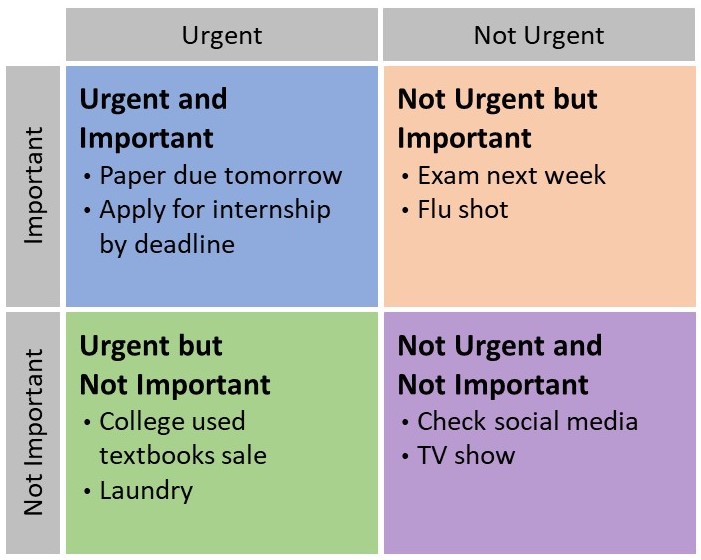24 Time Management
Time Management
Emilie Jackson
Learning Objectives
After reading this page, you will be able to:
- understand the importance of time management;
- use time management strategies to succeed in college.
Why Is This Important?
A very unfortunate but all-too-common situation in higher education is the challenges students face from poor time management. A single mishap or a case of poor time management can set into motion a series of events that can seriously jeopardize a student’s success. While it may not be possible to prevent life challenges while you are in college, you can do a great deal to prevent the chaos and the chain reaction of unfortunate events that they can cause. This can be accomplished through thoughtful prioritization and time management efforts.[1]

Balancing College, Work, and Life
The academic year is divided up in to terms or semesters. While dividing up the academic year results in varied learning opportunities, it also means new faces in classes, unknown expectations from new teachers, and juggling a new schedule. It means you may have new routes to travel on campus as you make your way to a different building or room. If a student is working as well as going to college, a change in term may mean negotiating new work hours with a boss and coworkers. Attending classes, studying, working, and finding time for family, friends, and yourself can be hard for college students to balance. How a student organizes their class load can affect their overall success in college.[2]
For college-level learning, you can expect to spend much more time on learning activities outside the classroom than you will inside the classroom: approximately two hours of outside learning for every one hour of lecture.[3] College classes tend to cover course material at a faster pace and expect students to carry more of the burden of learning the material on their own, outside of classroom activities. Not all classes are worth the same amount of credit or have the same attendance requirements. Some classes may have additional lab requirements, while classes with writing assignments will require preparing, editing, and revising time outside of class.[4] Some weeks may be more intense, depending on the time of the semester and the courses you are taking. Unfortunately, many students do not always take this into consideration, and they spend far less time than is needed to be successful.[5]
Exercise
This survey has been designed to help you identify the challenges you may face when trying to manage your time in college. Reflect on each statement and answer honestly. This activity is not scored.
| 1. I admit it. Just like everyone else, I feel that I am lazy when it comes to getting my assignments and/or work done. | |||
| Usually | Sometimes | Rarely | Never |
| 2. I am disorganized when it comes to getting my assignments and/or work done. | |||
| Usually | Sometimes | Rarely | Never |
| 3. I get confused about what I am supposed to do for the assignment or task. | |||
| Usually | Sometimes | Rarely | Never |
| 4. I have a hard time saying “no” to others which puts me behind in my work/studies. | |||
| Usually | Sometimes | Rarely | Never |
| 5. When I was in high school it wasn’t a problem studying for most tests the night before. | |||
| Usually | Sometimes | Rarely | Never |
| 6. When what I have to study or accomplish is just not that important to me, I find it more tempting to procrastinate. | |||
| Usually | Sometimes | Rarely | Never |
| 7. I think I have more time to finish something than I usually do. | |||
| Usually | Sometimes | Rarely | Never |
| 8. I am very social and spending time with my friends sometimes gets in the way of doing my work. | |||
| Usually | Sometimes | Rarely | Never |
| 9. I am easily distracted by people or other personal tasks when I am studying at home. | |||
| Usually | Sometimes | Rarely | Never |
| 10. I can’t seem to stay away from social media. | |||
| Usually | Sometimes | Rarely | Never |
Which statements did you answer with “Usually” or “Sometimes”? What other challenges might you face that are not in the list? (Possible challenges might include a disability, mental health challenges, family responsibilities, work hours, or other life stressors.) What strategies could you use to overcome these challenges?[6]
Time Management Strategies
While time management is a regular challenge for college students, strategies such as getting organized, prioritizing your tasks, avoiding procrastination, and reflecting on your goals, can help you manage your time successfully.
Get Organized
Organization is an important part of being a successful college student. Continue reading to learn how to create a term or semester schedule, break down large tasks, and use small blocks of time to help you get organized and stay organized.
Create a Term or Semester Schedule
One important aspect of organization is knowing the important dates for your classes and the college in general. Academic deadlines matter and deadlines in college may not be flexible. A student needs to be aware of key dates throughout the term. The responsibility for knowing important dates lies with the student. A course syllabus is prepared by your instructor and is like a roadmap for your learning journey ahead. The course syllabus that you get for each class you take will have important dates for that specific class. The college will also put important dates on an academic calendar for the school.
Examples of key dates to know for a college:
- Term/semester start and end dates
- Holidays or campus closures
- Last day to drop a class with a complete refund
- Last day to drop a class
- Exam or finals week [7]
The following video will help you to better understand how to read your syllabus and how to plan for the semester ahead.[8]
A semester schedule gives you a visual picture of the tasks and events that will happen during the semester. If you are taking a number of classes, this is a tool that will help you see what is coming up next. You may wish to use different colours to distinguish between different classes, or between your academic events and personal events.[9]
Break Down Large Tasks
One of the biggest challenges college students may have is accurately estimating how much time it will take to complete a task. We might think we’re going to be able to read an assigned chapter in an hour, but what if it takes three hours to read and understand the chapter? Having the skill to know how long a homework assignment will take is something that can be developed. However, until we can anticipate work and study time accurately, it is best to leave some time in our schedule in case it takes longer than we had anticipated.[10]
How you divide the time is up to you. If it is going to take you five hours to study for a final exam, you can plan to spread it over five days, with an hour each night, or you can plan on two hours one night and three hours the next. What you do not want to do is plan on studying only a few hours the night before the exam only to find out that you greatly underestimated the time that you would need. If that happened, you would run out of time before finishing, with no way to go back and get more time to study. In this kind of situation, you might even be tempted to or “cram” or “pull an all-nighter,” which means going without sleep for the entire night and using that time to study. While this method of trying to make up for poor planning is common enough to have a name, rarely does it produce the best work.[11]
Use Small Blocks of Time
By using smaller blocks of time, you can cover material in chunks and not have to worry about the larger whole. A mistake that many people make is that they try to cram information into their minds in one large session. This isn’t a successful strategy for most students.
Look for smaller blocks of time to study. If you are a public transit user, you can likely spend 20 minutes on your bus ride to read or review for your upcoming class or exam. You could even listen to an audio recording of your notes. In the evening, instead of watching three episodes of your favourite TV show, you could watch one and spend the remaining time preparing for your studies. Do you go out to eat often? Consider making something simple at home that you could cook in the oven untended; that time could be used for studying and still leave you time for other activities once dinner is finished.[12]
Exercise
Making time for your studies can be overwhelming. The following video introduces you to ways of using smaller blocks of time to get your tasks done while not using up numerous hours at once.
Watch the video and answer the questions (by clicking on the icons that appear) to further your learning.[13]
Prioritize Your Tasks
People like to check things off that they have completed because it feels satisfying but don’t confuse productivity with accomplishment of tasks that aren’t important. You could have a long list of things that you completed, but if they aren’t important to you, it probably wasn’t the best use of your time. It is important to prioritize your tasks so the most important tasks get completed first.[14]
Continue reading to learn how to use the time management matrix and daily top three strategies to help you prioritize tasks.

Time Management Matrix
To better see how things may need to be prioritized, you can make a list of the tasks you need to complete and then arrange them based on importance and urgency in a quadrant map often called a Time Management Matrix.[15]
To create a matrix, you begin by making a list of things you need or want to do in a day and then draw your own version of the grid below. Write each item in one of the four squares; choose the square that best describes the item based on its urgency and its importance. When you have completed writing each of the tasks in its appropriate square, you will see a prioritization order of your tasks.
Review the following example of a completed Time Management Matrix and try creating one of your own:
- Urgent and Important (blue quadrant)
- Not Urgent but Important (orange quadrant)
- Urgent but Not Important (green quadrant)
- Not Urgent and Not Important (purple quadrant)[16]

Daily Top Three
The idea behind the daily top three approach is that you determine which three things are the most important to finish that day and these become the tasks that you complete. It is a very simple technique that is effective because each day you are finishing tasks and removing them from your list. Even if you took one day off a week and completed no tasks on that particular day, a daily top three strategy would have you finishing 18 tasks in the course of a single week. That is a significant number of things crossed off your list.[17]
Avoid Procrastination
To succeed at time management, you must understand some of the hurdles that may stand in your way. Procrastination is often one of the biggest. Procrastination is when you avoid doing some tasks that need to be completed. Often we procrastinate because we feel overwhelmed by the task and can’t figure out how to get started with it. It is something we all do to greater and lesser degrees. Continue reading to learn how to manage distractions and use the Pomodoro technique to help you avoid procrastination.
Manage Distractions
Distractions are a significant cause of procrastination. It is so easy to play a video game a little while longer, scroll social media, or finish watching a movie when we are avoiding a task. Putting aside distractions is one of the primary functions of setting priorities so that important tasks get completed.[18]
Some distractions are obvious: your friend sends you a text, your family needs your attention, or there is loud construction outside the window. However, other distractions are less obvious. Sometimes we can be distracted by our thoughts and feelings. When we are feeling stressed or overwhelmed, these internal causes can be just as distracting. One way to deal with internal distractions is to keep a study journal. At least once a day write an entry about how you have used your time and whether you succeeded with your schedule for the day. If you struggled to keep your daily schedule, identify what factors kept you from doing your work. This journal will help you see your own habits and distractions so that you can avoid things that lead to procrastination.[19]
Pomodoro Technique
A key aspect of overcoming procrastination is developing strategies to get started. Often, committing to complete one small task can be enough to begin moving ahead. For example, just taking out your laptop, opening a new document, and typing a title can create some forward momentum. A well-known technique for managing time that can help with procrastination is called the Pomodoro Technique.[20] The Pomodoro Technique was developed by Francesco Cirillo. The basic concept is to use a timer to set work intervals that are followed by a short break. The intervals are usually about 25 minutes long and are called pomodoros, which comes from the Italian word for tomato because Cirillo used a tomato-shaped kitchen timer to keep track of the intervals. Setting a timer is a small task that will provide you with the momentum to overcome procrastination.

Follow these six steps to follow the Pomodoro technique:
- Decide on the task to be done.
- Set the timer to the desired interval (for example, 25 minutes).
- Work on the task.
- When the timer goes off, put a check mark on a piece of paper.
- If you have fewer than four check marks, take a short break (3–5 minutes), then go to Step 1 or 2 (whichever is appropriate).
- After four checkmarks, take a longer break (15–30 minutes), reset your check mark count to zero, and then go to Step 1 or 2.
This technique is deemed effective for many people because it reduces mental fatigue by encouraging breaks and it tends to encourage people to get started on a task. Also, by breaking tasks down into things that can be completed in 25-minute blocks, more can be completed in one day because it is much easier to squeeze in three 25-minute sessions of work time than it is to set aside a 75-minute block of time.[21]
Exercise
What do you know about the Pomodoro Technique? Fill in the blanks below to test your knowledge.[22]
Reflect on Your Goals
In general, we will always make time for the things that matter. We already discussed the importance of setting goals in the previous chapter, but having clear goals will also help you manage your time and help you learn to balance college, work, and life. Watch Laura Vanderkam’s TED Talk “How to gain control of your free time” to hear a new perspective on time management.
Key Takeaway
Balancing college, work, and life is challenging, but time management strategies can help college students organize their schedule, prioritize, avoid procrastination, and focus on their goals.
- College Success by Amy Baldwin, licensed under a Creative Commons Attribution-ShareAlike 4.0 International License. https://openstax.org/books/college-success/pages/3-1-the-benefits-of-time-management ↵
- A Different Road to College: A Guide For Transitioning To College For Non-traditional Students by Alise Lamoreaux, licensed under a Creative Commons Attribution-ShareAlike 4.0 International License. https://openoregon.pressbooks.pub/collegetransition/chapter/chapter-5/ ↵
- https://openstax.org/books/college-success/pages/3-2-time-management-in-college ↵
- https://openoregon.pressbooks.pub/collegetransition/chapter/chapter-5/ ↵
- https://openstax.org/books/college-success/pages/3-2-time-management-in-college ↵
- Adapted from Blueprint for Success in College and Career by Dave Dillon, licensed under a Creative Commons Attribution-ShareAlike 4.0 International License. https://press.rebus.community/blueprint2/chapter/18-procrastination/ ↵
- https://openoregon.pressbooks.pub/collegetransition/chapter/chapter-5/ ↵
- Time Management for Busy Students by KPU Learning Centres, licensed under a Creative Commons Attribution-ShareAlike 4.0 International License. https://kpu.pressbooks.pub/timemanagement/chapter/using-your-course-outline-to-prepare-for-the-semester/ ↵
- https://kpu.pressbooks.pub/timemanagement/chapter/scheduling-your-semester/ ↵
- https://press.rebus.community/blueprint2/chapter/16-time-management-reality/ ↵
- https://openstax.org/books/college-success/pages/3-4-how-to-manage-time ↵
- https://kpu.pressbooks.pub/timemanagement/chapter/using-small-blocks-of-time-productively/ ↵
- https://kpu.pressbooks.pub/timemanagement/chapter/using-small-blocks-of-time-productively/ ↵
- https://press.rebus.community/blueprint2/chapter/14-time-management-theory/ ↵
- https://press.rebus.community/blueprint2/chapter/14-time-management-theory/ ↵
- https://openstax.org/books/college-success/pages/3-5-prioritization-self-management-of-what-you-do-and-when-you-do-it ↵
- https://openstax.org/books/college-success/pages/3-7-enhanced-strategies-for-time-and-task-management ↵
- https://openstax.org/books/college-success/pages/3-3-procrastination-the-enemy-within ↵
- Student Success by Mary Shier, licensed under a Creative Commons Attribution-ShareAlike 4.0 International License. https://ecampusontario.pressbooks.pub/studentsuccess/chapter/strategies/ ↵
- https://kpu.pressbooks.pub/timemanagement/chapter/use-the-pomodoro-method-to-get-started/ ↵
- https://openstax.org/books/college-success/pages/3-7-enhanced-strategies-for-time-and-task-management ↵
- https://kpu.pressbooks.pub/timemanagement/chapter/apply-the-pomodoro-technique/ ↵

